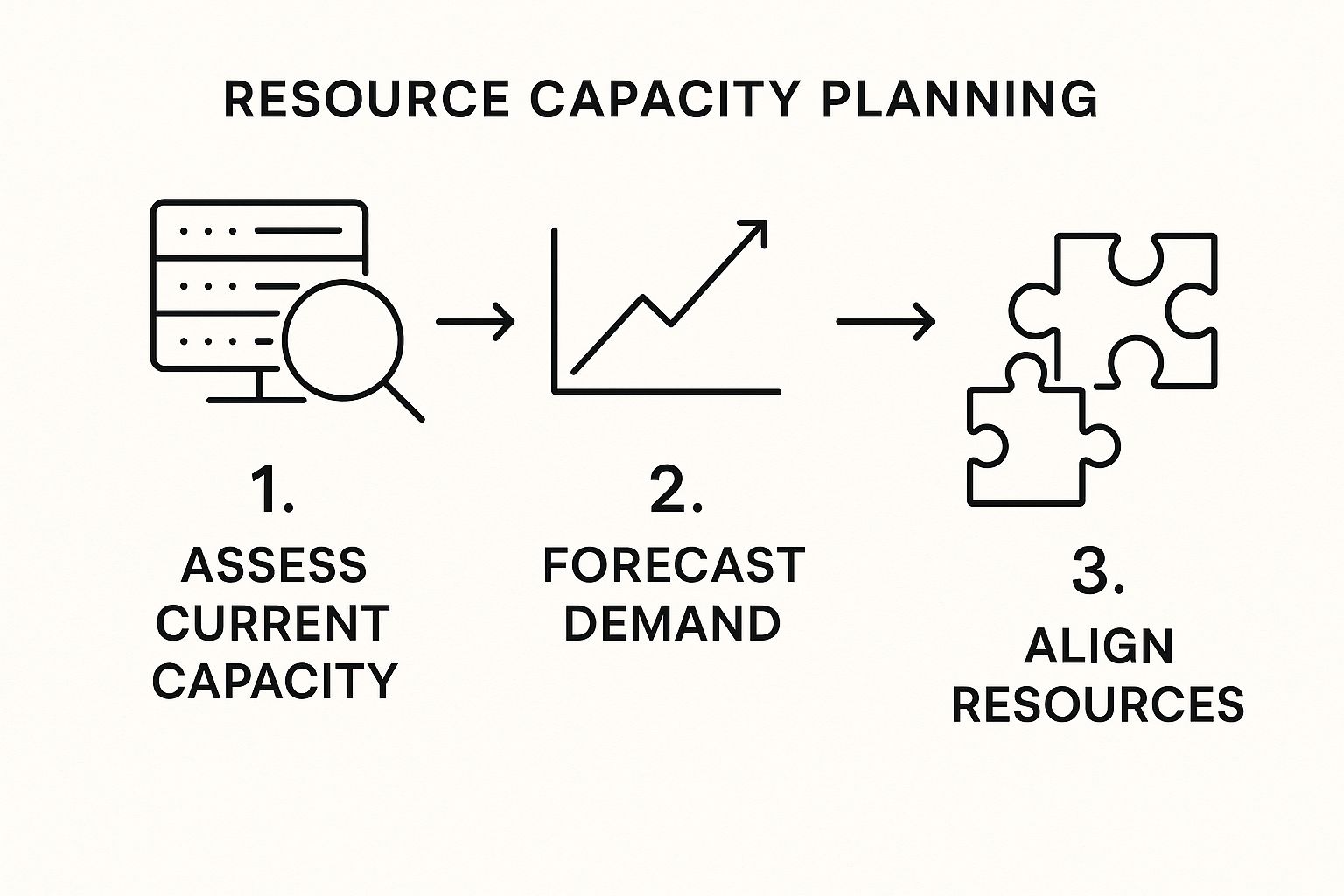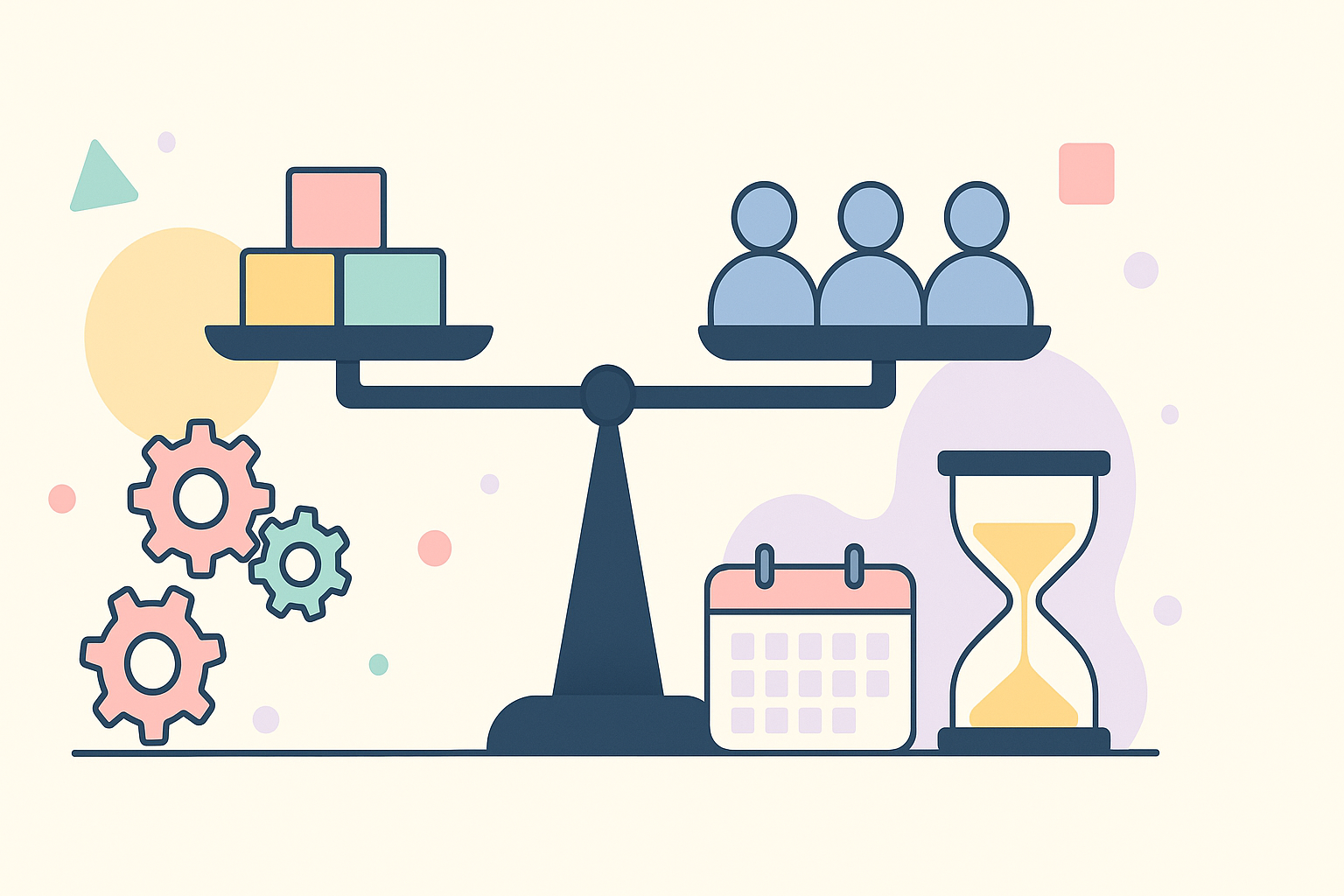Let’s be real, “resource capacity planning” has a certain ring to it—the kind of corporate jargon that makes eyes glaze over. But here’s the thing: it’s one of the most critical, ground-level activities that separates teams that consistently deliver from those that are always just putting out fires.
This isn’t about filling out spreadsheets for the sake of it. It’s the strategic process of figuring out what your team can realistically accomplish with the time and skills they have. It’s the essential link between having a talented group of people and actually shipping projects on time and within budget. Without it, you’re just guessing.
Why Resource Capacity Planning Actually Matters

Think of it like an airline managing its fleet. They would never sell seats on a flight without first confirming they have a plane, a qualified crew, and a clear slot in the schedule. To do so would be a one-way ticket to chaos, cancellations, and a lot of very angry customers.
Resource capacity planning brings that same common-sense logic to your projects. It’s how you make sure you have the right people, with the right skills, available at the right time to do the work.
The Strategic Importance of Capacity Management
Flying blind is a recipe for some of the most common pains in business. When you don’t have a clear view of your team’s capacity, you inevitably overcommit. That leads directly to employee burnout, a nosedive in quality, and a calendar full of missed deadlines. Your team gets stuck in a reactive state, lurching from one “fire drill” to the next instead of moving forward with proactive, organized work.
This isn’t a secret. Research shows that while 90% of business leaders see building capacity as a pressing issue, a tiny 5% feel they are truly prepared to handle it. It’s no wonder that strategic workforce planning has shot up to become a top-three priority for HR leaders, right behind leadership and culture. You can dive deeper into these capacity planning statistics and their impact.
Getting this right isn’t just an admin task—it’s a massive strategic advantage. It gives you clear, confident answers to the questions that keep managers up at night:
- Can we actually take on this exciting new client?
- Is our lead developer completely swamped for the next three months?
- Do we need to hire another designer to hit our roadmap goals?
- Are we about to burn out our entire support team?
Core Components of Resource Capacity Planning
A solid capacity planning strategy really boils down to three key parts. Once you get these, the whole process becomes much less intimidating and a lot more practical.
Here’s a quick breakdown of the core components that make up any effective resource capacity plan.
| Component | Description | Key Objective |
|---|---|---|
| Resource Supply | This is the total number of work hours your team has in the tank. It considers everyone’s schedule, their unique skills, and all planned time off like vacations and holidays. | To get a realistic, honest picture of your team’s true availability. |
| Project Demand | This covers all the work on your plate and in the pipeline. It includes confirmed projects, potential new business, and all the ongoing operational tasks that keep the lights on. | To accurately forecast the total effort required to meet your business goals. |
| The Balancing Act | This is the active, ongoing process of aligning supply with demand. It’s where you schedule tasks, prioritize projects, and make decisions to close any gaps between what you want to do and what you can do. | To make sure every project is staffed for success without overloading anyone. |
At the end of the day, effective resource capacity planning is the blueprint for sustainable growth and operational health. It’s what protects your budget from spiraling out of control, prevents your team from burning out, and sets your most important projects up for a win right from the start.
The Real-World Benefits of Effective Capacity Planning

Sure, the theory behind resource capacity planning sounds nice. But the real magic happens when you see it in action. It’s the difference between a team that’s constantly scrambling and one that delivers with predictable calm. This isn’t just about tweaking a few schedules; it’s about fundamentally changing how your business operates for the better.
Ever seen a team stuck in a never-ending cycle of “fire drills”? Every week brings a new crisis, deadlines are always slipping, and everyone’s working late just to keep their heads above water. That’s the chaotic reality for so many teams trying to fly blind without a clear grasp of their own capacity.
Now, imagine that same team six months later. They’ve finally put a solid capacity planning process in place. Suddenly, project timelines are actually achievable. Work is spread out evenly. And for the first time in a long time, there’s no mandatory overtime. This isn’t a fantasy—it’s the direct result of matching the work to the team’s actual availability.
Improve Project Outcomes and Predictability
One of the first things you’ll notice is a huge leap in project reliability. When you know your team’s true capacity, you stop building project plans on wishful thinking and start grounding them in reality. It’s a proactive stance that helps you sidestep some of the most common—and costly—project management traps.
Good capacity planning hits these critical failure points head-on:
- Eliminating Over-Estimation: You finally stop assuming everyone is available 100% of the time, which leads to more accurate timelines and fewer bottlenecks down the road.
- Preventing Skill Mismatches: You can map the right skills to the right project needs, ensuring the perfect person is on the right task. This move alone boosts both quality and efficiency.
- Avoiding Scope Creep: A clear plan makes it painfully obvious how new requests will impact capacity, forcing crucial conversations about priorities before you overcommit.
By knowing your resource availability upfront, you transform project management from a guessing game into a reliable process. It’s a huge advantage to know your project plan is not just a document, but an achievable roadmap.
This kind of foresight builds incredible trust with clients and stakeholders. When you tell them a project will be done by a certain date, you can say it with confidence because your plan is backed by data, not just hope.
Boost Team Morale and Stop Burnout
Constant pressure and impossible deadlines are a surefire recipe for burnout. It’s no secret—research shows that a staggering 77% of professionals have felt the sting of burnout, with unrealistic workloads being a major culprit. Chronic overtime isn’t a badge of honor; it’s a glaring symptom of bad planning.
Bringing in resource capacity planning is one of the most powerful things you can do for your team’s well-being. It helps ensure workloads are balanced and sustainable, and that positive vibe ripples across the entire team. A manageable workload leads directly to higher job satisfaction, more creativity, and lower employee turnover. In fact, smart staff capacity planning is a key ingredient for creating a healthier, happier work environment.
Increase Profitability and Resource Efficiency
Finally, let’s talk about what really gets leadership’s attention: the bottom line. Good capacity planning has a direct, positive impact on your organization’s profitability. Wasted resources—whether it’s an expert sitting idle or a senior developer stuck on low-priority tasks—are a quiet drain on your budget.
Here’s how it translates to real financial wins:
- Optimized Resource Allocation: You can assign tasks to the most cost-effective person who can do the work, protecting your project margins from unnecessary expenses.
- Data-Informed Hiring: By tracking how skills are being used, you can pinpoint which roles are true bottlenecks. This lets you make strategic hiring decisions instead of just reacting to staffing fires.
- Reduced Rework: When teams aren’t rushed, the quality of their work goes up. That means fewer mistakes and less time wasted on frustrating fixes.
By making sure every project is staffed for success from the get-go, you’re not just protecting your people—you’re protecting your profits and building a truly sustainable model for growth.
A Practical Framework for Capacity Planning
The whole idea of resource capacity planning can sound a bit intimidating. It conjures images of complex software and dedicated teams of analysts, but that’s not the reality. You can get started today with a simple, repeatable framework. This isn’t about achieving perfection overnight; it’s about building a solid process that brings much-needed clarity and predictability to your work.
Let’s break it down into manageable stages. Don’t think of it as one giant leap, but rather a series of connected steps: first, figure out your team’s real capacity, then accurately forecast project demand, find and fix any gaps, and finally, put your plan into motion. This approach makes the whole thing less mysterious and gives you a clear path to follow.
This infographic lays out the core process flow, breaking it down into three simple, interconnected phases.

As the visual shows, success starts with taking stock of what you have, forecasting what you’ll need, and then lining up the two to create a balanced, realistic plan.
Stage 1: Measure Your True Capacity
First things first, you need an honest picture of your team’s available work hours—your “supply.” This is more than just multiplying your team members by 40 hours a week. A real capacity calculation has to account for all the things that actually eat up time in a modern workplace.
To get this number, start with the total available hours and then subtract all the non-project time. This includes things like:
- Administrative Tasks: All that time spent on emails, company-wide meetings, and other general admin work.
- Time Off: Planned vacations, public holidays, and even a buffer for those unexpected sick days.
- Professional Development: Any time set aside for training, workshops, or learning new skills.
The number you’re left with is your team’s net capacity. This is the actual number of hours your team has for dedicated project work, and it’s the bedrock of your entire plan.
Stage 2: Forecast Project Demand
Now that you have a clear picture of your supply, it’s time to understand the “demand.” This step is all about forecasting the total effort required for all your current and upcoming projects. The goal here is to shift from educated guesses to data-backed predictions.
Start by listing out all your projects—both the ones that are confirmed and those still in the pipeline. For each project, break it down into major tasks or phases and estimate the hours needed. You can pull these estimates from:
- Historical Data: How long did similar projects take in the past? Your own history is your best teacher.
- Expert Judgment: Simply ask the people who will be doing the work. They often have the most accurate feel for the effort involved.
- Sales Pipeline: Chat with your sales team to get a handle on the likelihood and potential scope of future work.
This kind of rigorous data collection is what separates good planning from great planning. Organizations that adopt these systematic processes often see a 15% improvement in operational efficiency within the first year alone.
Stage 3: Identify and Resolve Gaps
Alright, now for the balancing act. You’ll compare your team’s net capacity (supply) with your forecasted project needs (demand). This is the moment of truth where you’ll spot the critical gaps—those times when demand completely outstrips your team’s ability to deliver. You might discover your developers are totally swamped in Q3, or maybe your design team has some breathing room in May.
Once you’ve identified a gap, you have a few levers you can pull to close it:
- Prioritize and Reschedule: Can any lower-priority projects be pushed to a later date when there’s more capacity?
- Adjust Scope: Is it possible to trim the scope of a project to make it fit within the available time?
- Reallocate Resources: Can a team member with the right skills and some free time jump in to help out?
- Strategic Staffing: Is this a recurring problem? It might be time to think about bringing in contractors or hiring a new full-time employee.
For teams looking to truly master this, modern tools can be a game-changer. It’s worth exploring how AI-driven workforce planning solutions can help automate and sharpen this gap analysis.
Stage 4: Put the Plan into Action
A plan is only as good as its execution. This final stage is all about turning your decisions into a clear, communicated schedule and—this is key—keeping it updated. This isn’t a “set it and forget it” task; it’s a dynamic process.
The goal of a capacity plan isn’t to create a rigid, unchangeable schedule. It’s to create a living document that provides the clarity needed to make smart, proactive decisions as priorities shift and new challenges arise.
To make it stick, you need a system for ongoing monitoring and adjustment. Hold regular weekly or bi-weekly check-ins. Are projects on track? Did something unexpected pop up? Building this feedback loop allows you to adapt quickly, keeping your team aligned and focused on what matters most.
For a head start, you can use our practical team capacity planning template to help structure your efforts from day one.
Measuring What Matters for Team Capacity
You can’t fix what you can’t see. When it comes to resource capacity planning, you have to get beyond gut feelings and start tracking the numbers that tell the real story of your team’s workload. These metrics are your command center, giving you a clear, data-backed view of how things are really going.
Once you start tracking these figures, you’re no longer just putting out project fires. You’re strategically managing your team’s most finite resource: their time. This kind of insight is crucial for heading off burnout, making smart hiring decisions, and keeping your projects on budget and on schedule.
The Core Metrics for Capacity Management
While you could track dozens of data points, a few core metrics deliver the biggest bang for your buck. Focusing on these essentials helps you avoid “analysis paralysis” and gives you real, actionable information you can use right away. Let’s break down the three most important KPIs every project manager and team lead should have on their radar.
Think of these as the foundational pillars of any solid capacity dashboard:
- Resource Utilization Rate: This shows you how much of your team’s available time is actually spent on productive, billable project work.
- Planned vs. Actual Hours: A direct comparison between your time estimates and the hours people actually log. It’s a fantastic reality check for your planning accuracy.
- Capacity Cushion (or Buffer): This is the unallocated time you intentionally set aside for all the unexpected tasks, urgent requests, and unforeseen risks that inevitably pop up.
A lot of people see a high utilization rate and think it’s a good thing. But if a team is consistently hitting 100% utilization, that’s not a sign of efficiency—it’s a massive red flag for burnout. It means there’s absolutely no room for error or unexpected work.
A Quick-Reference Guide to Capacity Metrics
To make these concepts crystal clear, here’s a simple table that breaks down each metric, how to calculate it, and what it’s telling you about your team’s health. You can think of this as a cheat sheet for turning raw numbers into meaningful conversations.
The table below is a great starting point for building your own capacity reporting.
Key Resource Capacity Planning Metrics
This table defines the essential metrics, their calculation formulas, and what they reveal about your team’s capacity and workload balance.
| Metric | Formula / Definition | What It Tells You |
|---|---|---|
| Resource Utilization | (Total Billable Hours / Total Available Hours) x 100 |
A healthy rate is typically 70-80%. Higher rates often signal a burnout risk, while lower rates could mean you’re under-scheduling or not allocating work effectively. |
| Planned vs. Actual Hours | (Actual Hours Logged - Planned Hours) / Planned Hours |
This metric exposes how accurate your project estimates are. If you see a consistently high variance, it’s a sign your forecasting process needs a tune-up. |
| Capacity Cushion | Total Capacity - (Billable Hours + Non-Billable Work) |
This is your team’s shock absorber for unplanned work. A healthy cushion (around 10-20% of total capacity) lets you handle surprises without derailing projects or stressing out the team. |
By keeping a regular eye on these figures, you shift from being reactive to proactive. Instead of scrambling when resource conflicts flare up or budgets get blown, you can spot the trends early, adjust your plans, and lead your team with genuine clarity and confidence. This is what data-driven capacity planning is all about.
How to Manage Capacity Planning in Jira
For so many agile teams, Jira is the command center. It’s fantastic for tracking tasks, sprints, and day-to-day progress. But when you try to step back and look at strategic resource capacity planning, using Jira’s native features can feel like you’re trying to build a skyscraper with a standard hammer. It gets the job done, sort of, but it’s not the right tool for the job.
The core issue is that Jira is brilliant at managing what’s happening right now. It offers very little visibility into future team availability. There’s no built-in way to see who is available next month, how planned vacations will throw a wrench in a project’s timeline, or if the dev team actually has the bandwidth for that new epic in Q3. This gap often sends managers right back to where they started: wrestling with disconnected spreadsheets to get the high-level view they desperately need.
This is where the Atlassian Marketplace really shines. It’s the bridge between Jira’s task management muscle and the strategic foresight that true capacity planning demands.
Bridging the Gap with Marketplace Apps
To get a real handle on your team’s workload without leaving your daily workflow, specialized apps are the only way to go. Tools like Tempo Planner are built specifically to add this missing layer of resource management right on top of your existing Jira projects.
These apps don’t just add features; they transform Jira from a task tracker into a genuine planning hub. Suddenly, you can:
- Visualize Team Availability: See who is available, who’s on vacation, and who is already booked solid—all in a clear, calendar-style view.
- Track Planned vs. Actual Time: Compare your initial estimates against the time your team actually logs. This is gold for refining future forecasts and getting more realistic.
- Generate Capacity Reports: Build dashboards that show utilization rates, flag potential bottlenecks before they happen, and arm you with the data you need for smart, strategic decisions.
The big idea here is to bring your planning and your execution into the same ecosystem. When your capacity plan lives right next to your project backlog, it stays relevant, visible, and is far more likely to be used and kept up-to-date.
This integrated approach means you can finally make informed decisions about project timelines and staffing without ever needing to export, copy, or paste. It connects the high-level strategy to the daily grind in a powerful, seamless way.
A Practical Walkthrough with Tempo Planner
So, what does this look like in the real world? An app like Tempo Planner lets you create detailed resource plans that account for everything from individual schedules and team holidays to project-specific work.
This screenshot gives you a glimpse of a typical resource planning view inside Tempo. You can see each team member, their allocated projects, and what capacity they have left.

You can instantly spot who is over-allocated (flagged in red) and who has room for more work. This makes rebalancing workloads incredibly easy before they become a real problem.
Getting started is pretty straightforward and usually involves a few key steps:
- Configure Team Workloads: First up, you define the working hours for each person on your team, making sure to account for part-time schedules or different work weeks.
- Log Non-Project Time: This is crucial. Team members or their managers log all future time off—vacations, public holidays, training days, you name it. This automatically reduces their available capacity for that time period.
- Plan Future Projects: Now you can start allocating individuals or whole teams to future epics and projects, blocking out their time. Tempo immediately shows you how this impacts their overall capacity.
This process gives you a dynamic, real-time picture of your team’s commitments. Of course, there are other great solutions for managing absences. For a deeper dive, check out our guide on using Jira gadgets for out-of-office and capacity planning. When used together, these tools give you a complete, actionable view of team availability, turning abstract planning into a concrete workflow inside the tool you use every day.
Best Practices for Sustainable Resource Management
Great resource capacity planning isn’t a “set it and forget it” task. It’s a living, breathing discipline that, when done right, gives you a serious competitive edge. Moving beyond the basics and into truly sustainable management is all about building transparency, resilience, and a team that’s always ready for what’s next.
It all starts with productive communication. Get in the habit of holding regular, no-fluff capacity review meetings. Whether it’s weekly or bi-weekly, use this time to talk about workloads, shuffle priorities, and spot potential bottlenecks before they can throw a wrench in your projects. This simple routine turns planning from a static document into a dynamic, team-wide conversation.
Build a Flexible and Transparent Team Structure
As you scale, juggling shared resources across multiple projects gets tricky. One of the best ways to get a handle on this is to create a team skills inventory. This isn’t just a list of job titles; it’s a rich map of who knows what—including their secondary skills, certifications, or hidden talents. This inventory makes it way easier to pull the right person for a task, even if they aren’t on the primary project team. If you’re managing people in different locations, you can explore how to manage remote teams effectively.
Just as critical is fostering a culture of transparency. Your team members need to feel psychologically safe enough to speak up about their workload without feeling judged. When someone can honestly say, “I’m at my limit,” it’s not a sign of weakness—it’s a crucial piece of data for your capacity plan.
True sustainability comes from creating a system where team well-being and project delivery are seen as two sides of the same coin. An open culture prevents the silent burnout that often derails even the best-laid plans.
Protect Your Plan from the Unexpected
Let’s be real: no project plan survives first contact with reality completely intact. Unplanned work, urgent “fire drill” requests, and unexpected problems are going to happen. The trick isn’t to avoid them, but to plan for them.
Always build a capacity buffer into your schedule. This simply means you don’t book every single available hour for planned tasks. A buffer of 10-20% is a good starting point, giving your team the breathing room to handle surprises without the chaos and stress that tanks morale and blows up deadlines.
Follow these practices for long-term success:
- Conduct Regular Reviews: Keep your plans grounded in reality with frequent check-ins.
- Share Resources Intelligently: Use a skills inventory to staff projects flexibly. Our guide on optimizing resource allocation digs deeper into this.
- Prioritize Transparency: Encourage honest conversations about workload and availability.
- Maintain a Buffer: Deliberately leave some room in the schedule for important but unplanned work.
By embedding these habits into your workflow, you’ll evolve from just scheduling tasks to strategically managing your team’s energy and focus for the long haul.
Frequently Asked Questions
Even with a solid plan, diving into resource capacity planning for the first time can feel like you’re navigating a new city without a map. A lot of questions pop up. Let’s tackle some of the most common ones I hear from teams just getting started, so you can move forward with confidence.
How Is Resource Capacity Different from Resource Planning?
This is a big one, and it trips a lot of people up. But the difference is pretty simple once you get it.
- Capacity Planning is your high-level, strategic view. Think of it as looking at your entire team and asking, “What’s the absolute maximum amount of work we can take on next quarter?” It’s all about the total supply of time and skills you have available.
- Resource Planning, on the other hand, is tactical and gets down to the nitty-gritty. It answers questions like, “Who, specifically, is handling this task on Tuesday morning?” This is the daily business of assigning individual people to specific jobs.
You have to do capacity planning first. It sets the realistic boundaries for your day-to-day resource planning, preventing you from promising work you simply can’t deliver.
Think of it like a road trip. Capacity planning tells you if you have enough fuel in the tank for the whole journey. Resource planning is deciding which car gets gas at which stop along the way. You need both to get where you’re going without running out of steam.
What Is a Realistic Utilization Rate to Aim For?
It’s so tempting to shoot for 100% utilization. I get it. It sounds efficient. But in reality, it’s a recipe for disaster. A team running at full throttle has no wiggle room for unexpected problems, last-minute requests, or even the creative thinking needed to solve tough challenges. It’s a fast track to burnout and sloppy work.
A much healthier and more sustainable target for most teams is somewhere between 70% and 80%. This sweet spot keeps your team focused and productive on their main projects but leaves a crucial buffer. That cushion is for all the other stuff that makes work happen: administrative tasks, meetings, and putting out those inevitable surprise fires without derailing everything else.
How Far in Advance Should We Plan Our Capacity?
There’s no single right answer here—it really hinges on your industry and how long your projects typically run.
- For fast-moving projects (like agile software development): A rolling 3-month forecast usually works best. It gives you enough of a runway to plan for upcoming epics without getting lost in long-term guesses that are almost guaranteed to change.
- For long-term projects (like in construction or enterprise consulting): You’ll need to look further out, typically 6 to 12 months ahead. This is essential for locking down budgets and making sure you have the right people secured for the long haul.
The trick is to find your balance. You want your plan to be strategic enough to guide you but flexible enough to adapt when things (inevitably) change. No matter your time frame, make it a habit to review and tweak your plan every month or quarter. It’s a non-negotiable best practice.
Managing absences is a massive piece of the capacity puzzle. resolution Reichert Network Solutions GmbH offers the Out of Office Assistant for Jira to automate handovers and keep projects on track, even when people are out. Keep your capacity plans grounded in reality by seamlessly integrating leave management into your workflow with our Out of Office Assistant for Jira Cloud.
